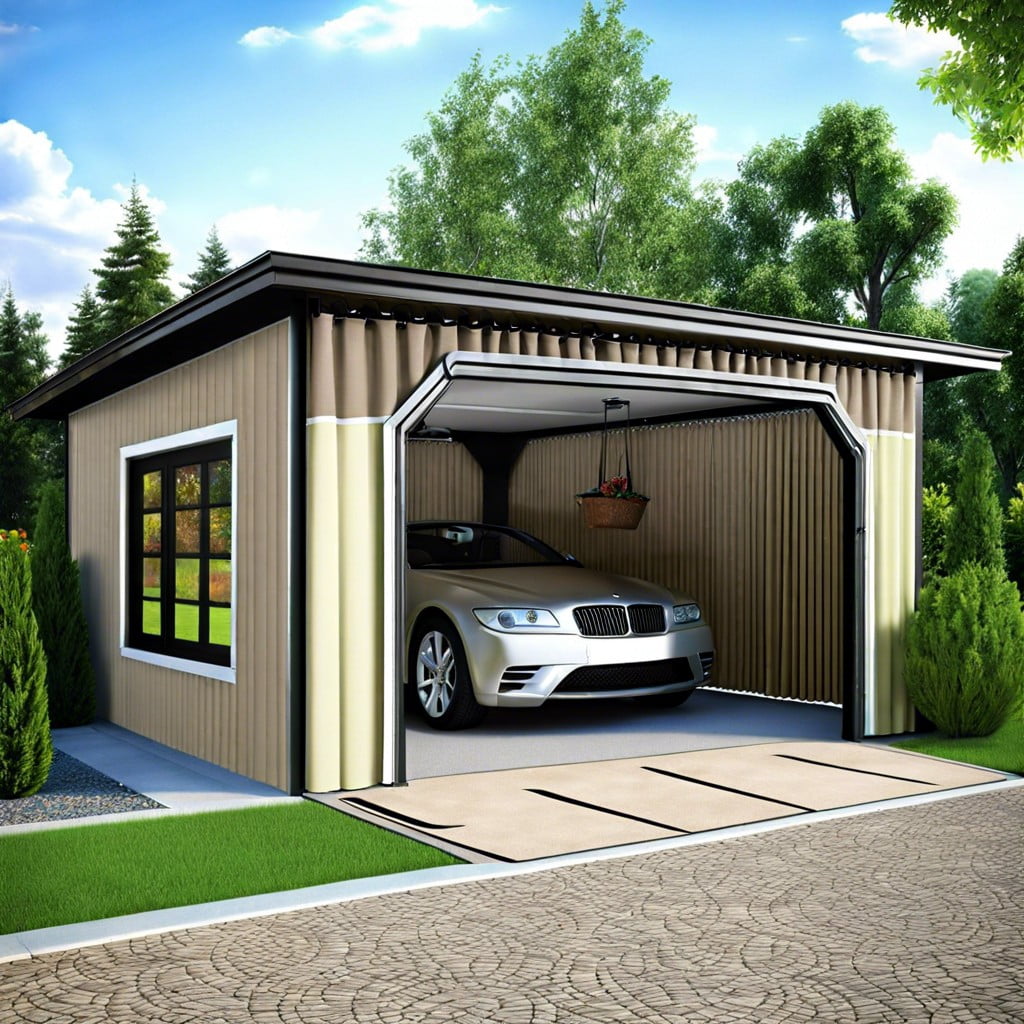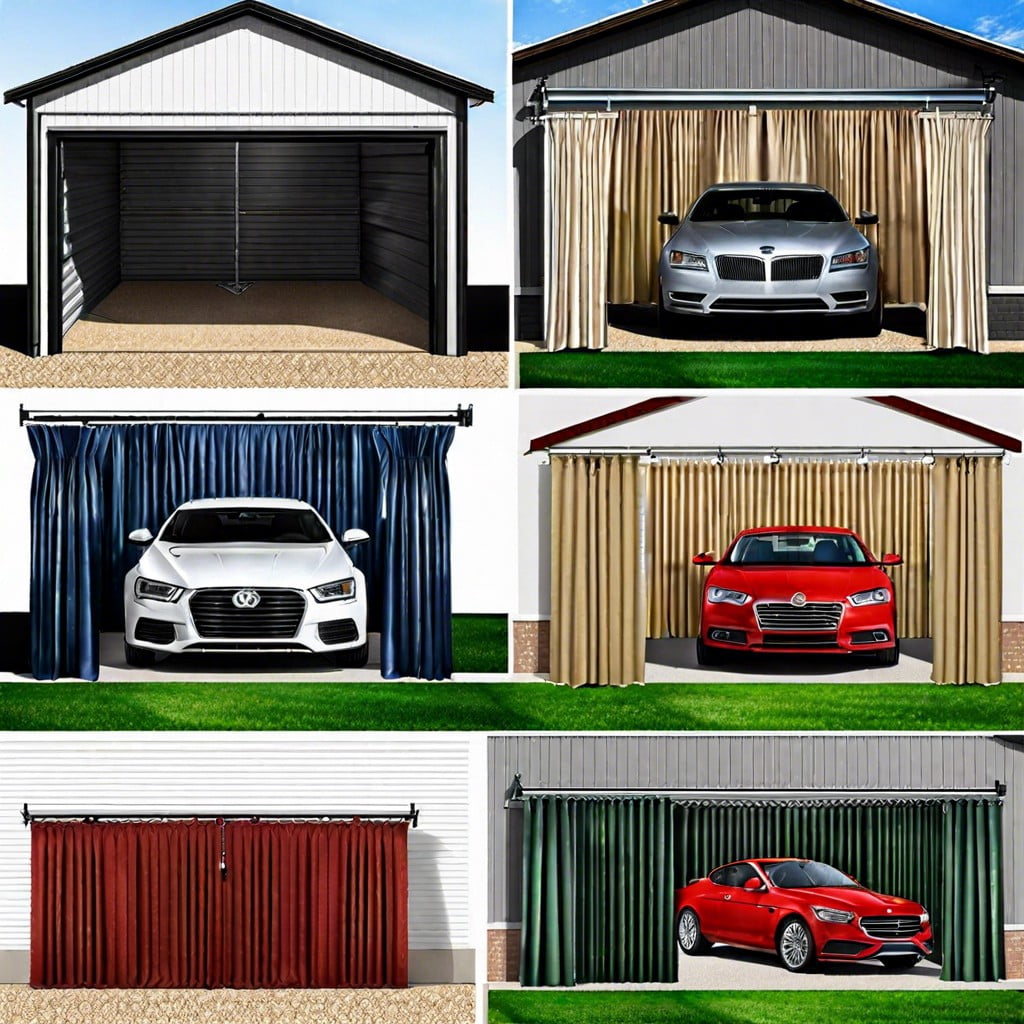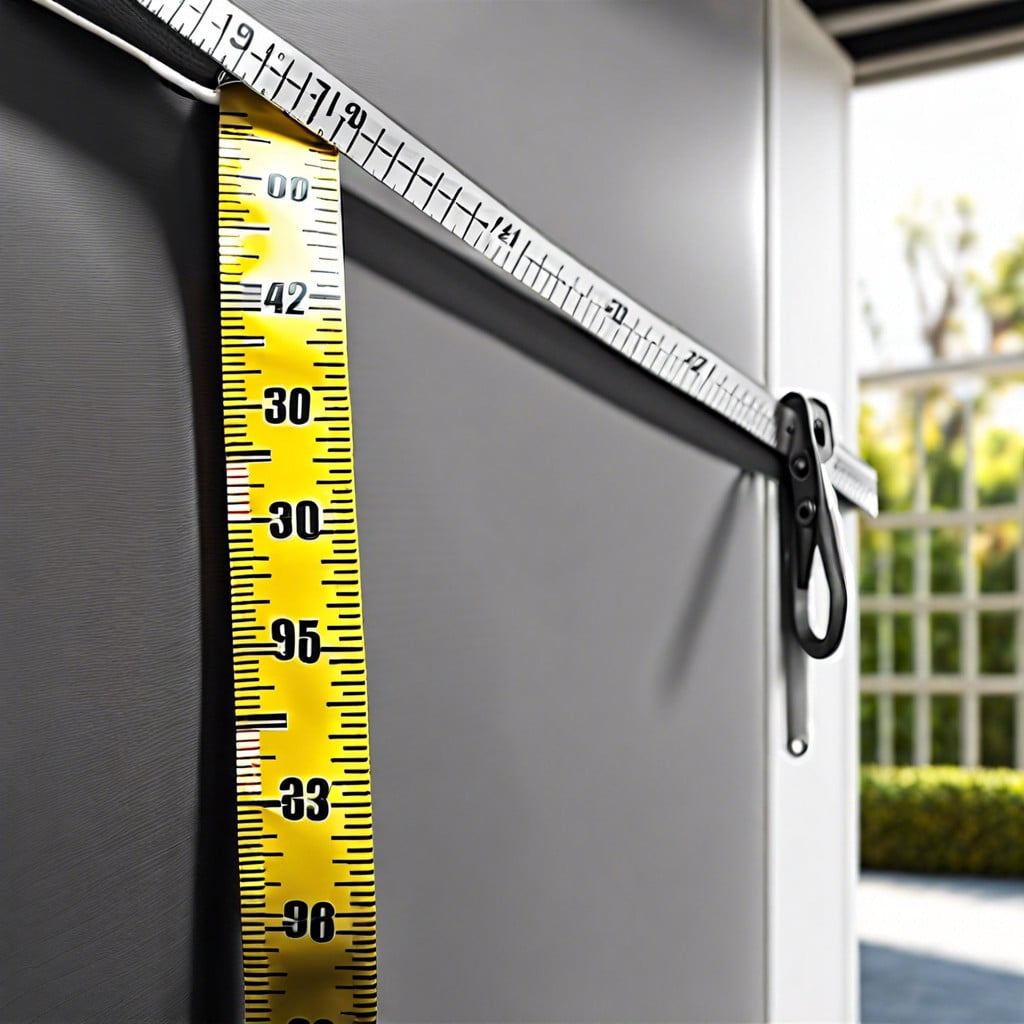Installing garage curtains can overhaul the aesthetic and functionality of your space because they bring in versatility, privacy, and style without heavy investment.
Key takeaways:
- Installing garage curtains has versatile benefits for space management.
- Consider factors such as purpose, material durability, and size before buying curtains.
- Choose the right layout and dimensions for maximum functionality.
- Select the appropriate curtain material and customize colors and patterns.
- Enhance functionality with features like clear vinyl windows and mesh panels.
Benefits of Installing Garage Curtains

Garage curtains present a versatile solution for space management and protection within a garage environment. They create convenient partitions, segmenting work areas or hiding clutter, which is particularly useful in shared or multipurpose garages.
The curtains serve as a barrier against dust, debris, and welding sparks, helping to maintain cleaner air quality and reducing cross-contamination between different garage zones. Additionally, they can offer a layer of insulation from noise and temperature fluctuations, enhancing comfort for those working inside.
With adjustable and retractable options, garage curtains afford flexibility, allowing for easy reconfiguration of the space as needs change. They also contribute to energy efficiency by containing heated or cooled air within designated areas, potentially lowering utility costs.
Factors to Consider Before Buying Garage Curtains

Selecting the right garage curtains involves evaluating several variables to ensure they meet your specific needs:
- Purpose: Determine the primary use of the curtains, whether for temperature control, dust reduction, or space division.
- Material Durability: Opt for heavy-duty materials if the curtain will face regular exposure to elements or mechanical stress.
- Temperature Control: For insulation purposes, choose thermally rated fabrics.
- Transparency and Light Control: Decide if you need curtains that allow light pass-through or provide complete opacity.
- Size and Fit: Measure the garage space accurately to ensure the curtains will fit as intended.
- Track System Compatibility: Ensure the curtain’s grommets or attachments are compatible with your track system for smooth operation.
- Fire Resistance: Look for fire-retardant materials if there’s a risk of exposure to sparks or flames.
- Ease of Cleaning: Consider materials that are easy to clean and maintain, particularly important in workshops or garages with high dust or dirt levels.
- Aesthetics: Find a design that complements your garage’s interior for an appealing look.
By considering these points, you’re poised to choose curtains that will serve your garage well, both functionally and visually.
Step 1 – Choose Your Layout

Selecting the right layout is crucial for maximizing the functionality and aesthetics of your garage space. Consider the following points to ensure effectiveness:
1. Assess the primary purpose of the curtains:
- Are they to create a partition for a workspace?
- Is the goal to contain dust or fumes?
- Are you aiming to establish a temperature-controlled zone?
2. Evaluate the garage’s current setup:
- Note the position of workbenches, storage, and equipment.
- Identify any obstructions that could affect curtain placement.
3. Determine the curtain track path:
The path can be straight, curved, or a combination of both to accommodate the garage’s shape.
4. Decide on the area to be enclosed:
Full enclosure offers complete separation. Partial enclosure can provide a flexible barrier while maintaining an open feel.
Remember to keep the natural flow of traffic and access in mind to prevent creating inadvertent bottlenecks or hazards. Visualizing the curtain’s position in relation to daily activities will streamline the selection process.
Step 2 – Enter Curtain Dimensions

Accurately measuring curtain dimensions is crucial for a perfect fit. Start by measuring the width of the area to cover, ensuring a full overlap with any walls or existing structures. For height, measure from the desired top point of the curtain to the floor.
Always double-check measurements before ordering. Remember to consider any additional space needed for mounting hardware or to accommodate uneven floors. If in doubt, consult with the curtain manufacturer for guidance on adding extra material to your measurement for optimal functionality and aesthetics.
Step 3 – Choose Your Curtain Material
Selecting the appropriate material for your garage curtains is vital for ensuring durability and functionality:
- Vinyl is a popular choice for its robustness and resistance to moisture, ideal for a garage environment.
- Heavy-duty PVC is recommended for areas that require welding or exposure to high temperatures, providing fire resistance and reducing hazards.
- Canvas and mesh options offer breathability, suitable for garages needing ventilation without sacrificing barrier protection.
- Consider transparent materials where visibility is crucial, especially in partitioning spaces without blocking light.
- Insulated fabrics are beneficial for temperature control, keeping garages warm during colder months and reducing energy costs.
- Acoustic materials are available for noise-sensitive setups like music studios or workshops needing sound dampening.
Customizing Curtain Colors and Patterns
Selecting the right hue and design for your curtains can transform the look of your garage. Opt for colors that complement the interior or your home’s exterior.
Light colors can brighten a dimly lit space, while dark shades are ideal for reducing glare and enhancing privacy.
Patterns range from subtle to bold, allowing for personal expression or branding for commercial garages.
Keep in mind that certain materials may hold dye better, resulting in more vibrant, longer-lasting colors.
Consider using digital printing for intricate designs or logos, adding a professional or personalized touch to your space.
Additional Curtain Features
Enhancing the functionality of garage curtains is simple with the right features. Consider clear vinyl windows to allow light in while maintaining privacy and partitioning.
If you’re working with welders or grinders, opt for flame-retardant materials to ensure safety against sparks or heat.
For those in colder climates, insulated curtains can help retain heat, making the garage more energy-efficient.
For added convenience, mesh panels can be integrated for ventilation, keeping airflow steady without compromising the separation of spaces.
Velcro or magnetic strips offer a seamless way to join curtain sections, providing a customizable and flexible arrangement.
Hooks and straps can also be included for easy retraction of the curtains when full access to the garage space is needed.
Incorporating Doors Into Garage Curtains
Adding doors to your garage curtains enhances functionality while maintaining the flexibility and separation that curtains provide. There are several styles to consider:
- Strip doors: Ideal for quick, hands-free access between zones. They’re made of clear, flexible plastic strips that part easily, then fall back into place.
- Roll-up doors: A great choice if you require wider access points for vehicles or equipment. These can be manually or mechanically operated.
- Walk-through slits: Simple cuts in the curtain with overlapping edges allow for easy pedestrian passage with minimal air exchange or temperature loss.
When integrating doors, ensure the curtain material is reinforced around the opening to prevent tears and that the door mechanism is compatible with the curtain’s hanging system. This seamless integration permits an efficient workflow and preserves the tailored environment your garage curtains have established.
Installation Overview
Begin by securing track systems or rods above the desired coverage area, ensuring they are level and can bear the curtain weight. Attach rollers or hooks to the curtains, based on the curtain or track type chosen. Slide the curtains onto the track or rod, confirming smooth operation. If necessary, apply curtain stops at each end to prevent them from sliding too far. Handle thermal or acoustic curtains with care to avoid damage to their functional layers.
Finally, anchor any bottom fasteners to maintain curtain position and limit movement in drafty conditions. Always refer to the manufacturer’s guidelines during installation for the best results.
Maintenance and Care for Garage Curtains
Regular cleaning extends the life of garage curtains and ensures they remain both functional and aesthetically pleasing. Dust or vacuum the surface to remove dirt and debris. For deeper cleaning, use a mild detergent and warm water, but avoid harsh chemicals as they can damage the material. Check the manufacturer’s instructions for any specific cleaning guidelines, particularly for specialized curtain fabrics.
Inspect the curtains periodically for wear and tear, especially along seams and at the points where they attach to the tracking system. Promptly repairing any small tears or loose stitching can prevent larger issues.
Ensure the track system is lubricated occasionally to facilitate smooth curtain movement. Silicone-based lubricants are typically preferred, as they don’t attract dirt.
Refrain from overstretching the curtains to prevent deformation. If your curtains include transparent sections or windows, keep them clear of scratches and cloudiness by using a soft cloth rather than abrasive cleaners.
If your curtains are exposed to the elements or mechanical work, consider treating them with a protective spray to resist water, oil, or stain penetration. This helps in maintaining a clean look and preserving the material.
Store the curtains correctly when not in use, ideally in a dry, enclosed space to protect them from moisture and pests. Fold them gently, avoiding sharp folds that may create creases.
By keeping up with these simple maintenance steps, your garage curtains will maintain both functionality and appearance, ensuring a well-protected and adaptable garage space.
FAQ
How do you section off a garage?
To section off a garage, one can utilize a window frame garage divider, which facilitates the creation of unique environments within smaller zones, often two large ones, while ensuring a balance between structure and light passage.
How high should curtains be off the floor?
The optimal height for curtains is just slightly above the floor.
What types of materials are best for garage curtains?
Heavy-duty polyester, vinyl and thermal insulated fabrics are considered best for garage curtains due to their durability, easy cleaning, and insulation properties.
How can curtains improve insulation in the garage?
Curtains can improve garage insulation by acting as a barrier to prevent heat transfer, thus maintaining a consistent room temperature and reducing energy usage.
How can curtains contribute to the overall design aesthetics of a garage?
Curtains can enhance the overall aesthetics of a garage by adding color, pattern, or texture, providing privacy, and sometimes creating a visual divider for multipurpose spaces.